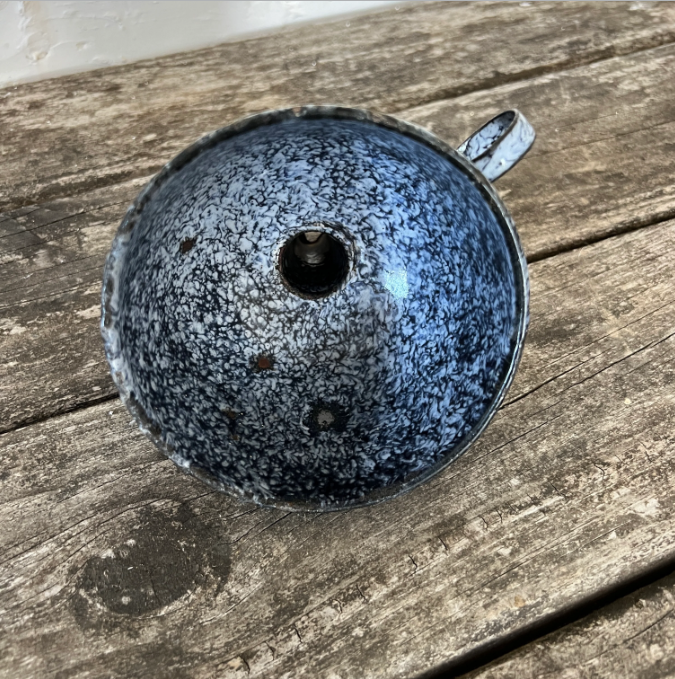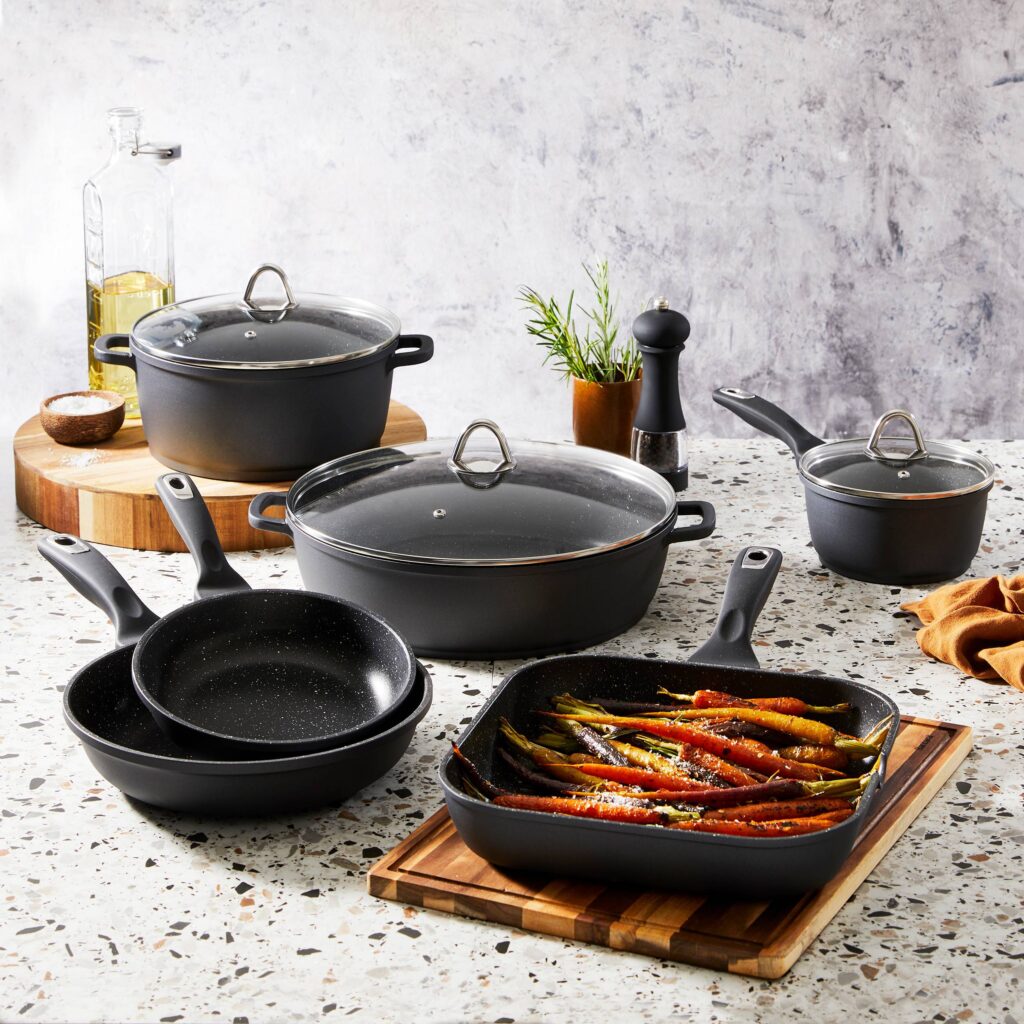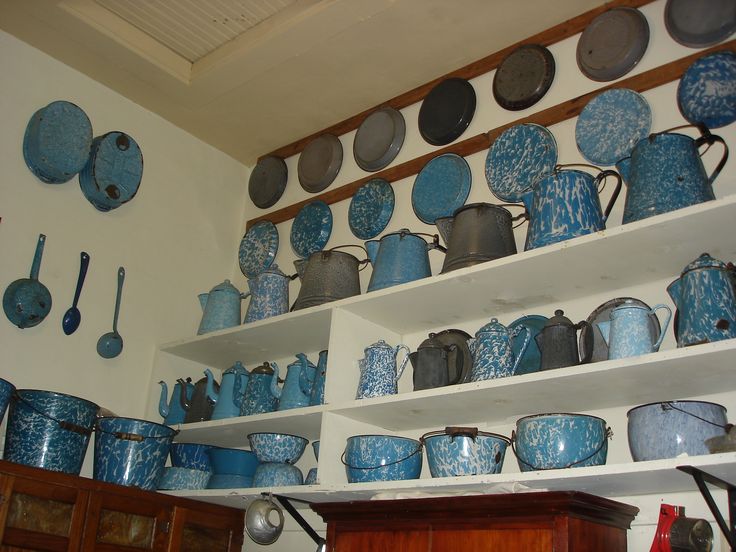If you’ve ever spotted that classic speckled cookware at your grandmother’s house or a yard sale, you might wonder if it’s actually safe to cook with. Granite ware has that nostalgic appeal, but does it belong in your kitchen or just on a shelf as decoration?

So What Exactly Is Granite Ware?
Despite the name, granite ware has nothing to do with actual granite stone. It’s really just steel or iron that’s been coated with porcelain enamel—basically a glass-like coating that gets baked onto the metal at super high temperatures (we’re talking over 1,500°F). That speckled pattern you see? That’s just how the enamel looks when it’s applied, creating those distinctive blue, white, or red flecks.
The metal underneath gives the pot its strength and helps spread heat around evenly. The enamel coating acts like a protective shield between your food and the metal, which stops any weird metallic tastes or reactions from happening.
The Good News About Safety
When your graniteware is in good shape, it’s actually pretty safe to use. The porcelain enamel doesn’t contain any of those sketchy chemicals you might worry about in modern non-stick pans—no PFOA, no PTFE, none of that stuff. The glass coating stays stable even when you’re cooking acidic things like spaghetti sauce or pickled vegetables.
The real issue pops up when the enamel gets chipped or cracked. Once that protective layer breaks down, you’ve got exposed metal that can rust. Plus, tiny bits of enamel could potentially break off into your food. And while accidentally eating a microscopic porcelain chip probably won’t hurt you, that exposed metal underneath might leach iron or other stuff into your meals, especially with acidic foods.
One heads-up about older pieces: if your granite ware is vintage (like pre-1970s), it might have trace amounts of lead or cadmium in the decorative enamel. Modern stuff doesn’t have this problem, but if you’re using grandma’s old pot, you might want to grab a lead testing kit just to be safe.
What Could Go Wrong?
Chips and Cracks: Drop your granite ware on a tile floor and you’ll probably see chips. Once that happens, the magic is kind of over. The protective coating is compromised, and you’ll start seeing rust spots where the metal’s exposed.
Vintage Pieces Can Be Sketchy: Older cookware wasn’t always made with today’s safety standards. Those bright, cheerful colors from decades ago? Sometimes made with lead-based glazes. Red and orange pieces tend to be the riskiest.
Not All Granite Ware Is Created Equal: Cheaper versions might have thinner enamel that chips more easily or doesn’t bond as well to the metal. You get what you pay for.
Temperature Shock Is Real: Take a hot pot and stick it under cold water? Bad idea. The sudden temperature change can crack the enamel. Same goes for putting a cold pot on a hot burner.

How to Use It Without Worrying
Stick to low or medium heat when you cook. The metal conducts heat really well, so you don’t need to crank things up. High heat can actually damage the enamel over time, and sudden temperature swings will stress it out.
Give your pots a quick look-over every now and then. Any chips, cracks, or weird dark spots mean it’s time to retire that piece from cooking duty. Maybe turn it into a planter instead!
Use wooden or silicone utensils instead of metal ones. Sure, the enamel is tough, but metal spoons and spatulas can scratch or chip it, especially around the edges where the coating might be thinner.
Wash by hand with gentle dish soap and a soft sponge. Dishwashers are convenient, but they’re pretty harsh on enamel with all those strong detergents and temperature extremes. Skip the abrasive scrubbers too—they’ll create tiny scratches that weaken the coating.
If you’ve got vintage pieces, test them for lead before using them with food. You can pick up lead testing swabs at most hardware stores, and they’re super easy to use. Even if an old pot isn’t safe for cooking, it can still look great as a decorative piece!

How Does It Stack Up Against Other Options?
Don’t confuse real granite ware with those modern “granite-look” pans you see advertised. Those newer ones usually have aluminum bases with synthetic coatings designed to look like granite. True porcelain enamel is totally different—no synthetic chemicals that break down or release fumes when heated.
Cast iron needs all that seasoning maintenance and doesn’t play nice with acidic foods. Granite ware? No seasoning needed, and tomato sauce is no problem. Stainless steel costs more and can have hot spots if it’s not made well. Glass cookware breaks if you look at it wrong and doesn’t heat as evenly.
What makes granite ware nice is that non-reactive surface without breaking the bank. Your marinara won’t taste metallic, it cleans up easier than cast iron, and it’s lighter too.
Your Burning Questions Answered
Can I put granite ware in the oven?
Yep! Most granite ware handles oven temps up to 450°F just fine. Double-check what the manufacturer says though, since handles or lids might have lower limits. Skip the broiler—that intense direct heat can wreck the enamel.
Is there Teflon in granite ware?
Nope, not at all. Granite ware uses porcelain enamel, which is basically glass fused to metal. Teflon is a completely different thing—it’s that synthetic non-stick coating. Totally different materials with different properties.

What are these black spots on my pot?
Black spots on new granite ware are usually just quirks from how it was made—areas where the enamel coating varies a bit. Totally normal. But if spots show up suddenly or start spreading on cookware you’ve been using, that might be rust from chips in the enamel. New spots are fine; developing spots mean trouble.
Does granite ware need to be seasoned like cast iron?
Not at all! That’s one of the best parts about it. The enamel coating is already smooth and non-reactive, so you can just wash it and start cooking. No oil rubbing, no special care routine—just use it.
Can granite ware be repaired if it chips?
Not really, at least not for cooking. There are some enamel repair kits out there, but they don’t create a food-safe surface that can handle heat and contact with food. Once it’s chipped, it’s done for cooking purposes. But hey, it can still be a cute flower pot or decorative piece!
Time to Say Goodbye?
If you see dark spots spreading from damaged areas, that’s rust forming on the base metal. Not only will it mess with your food’s taste, but you’re also getting unwanted iron compounds in there.
Notice a rough texture or fine cracks (called crazing) in the enamel? The coating’s breaking down. Those tiny cracks let moisture and acids sneak through to the metal underneath.
Got multiple chips, or any chip bigger than a small pea? The protective barrier isn’t doing its job anymore. Plus, sharp enamel edges could flake off into your food—definitely not appetizing.
Stains that won’t come out no matter what you try might mean the enamel has become porous. Once that smooth, glass-like surface breaks down, bacteria can hide in those microscopic spaces.
